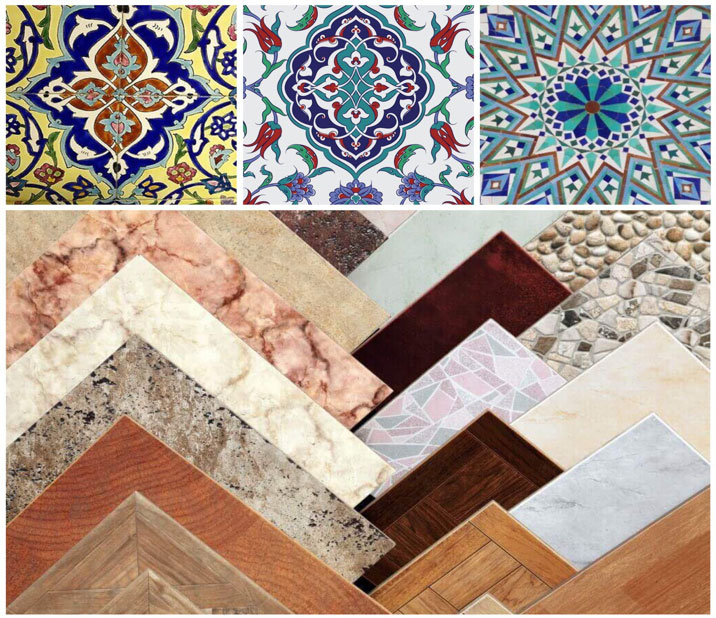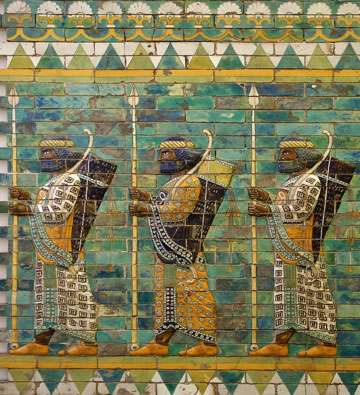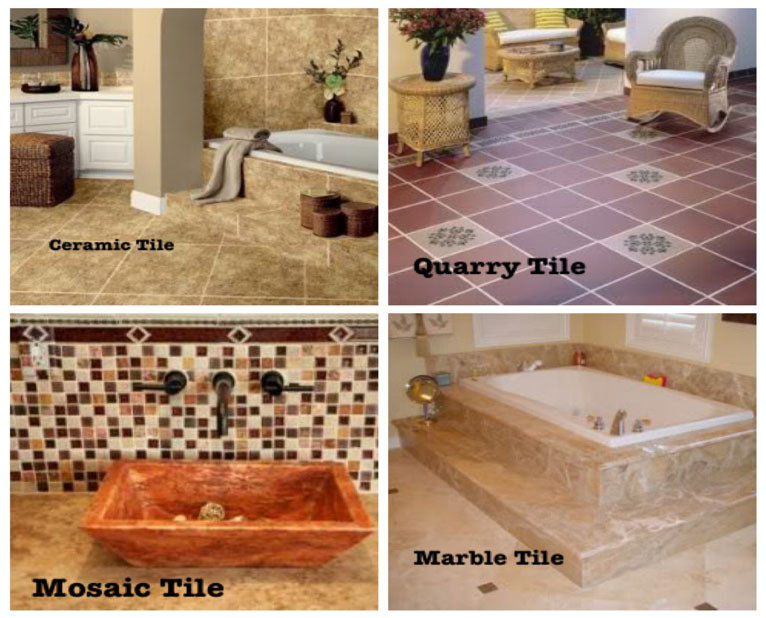TILES

A tile is a thin object usually square or rectangular in shape. Tile is a manufactured piece of hard-wearing material such as ceramic, stone, metal, baked clay, or even glass, generally used for covering roofs, floors, walls, or other objects such as tabletops. Tiles are often used to form wall and floor coverings, and can range from simple square tiles to complex or mosaics. Tiles are most often made of ceramic, typically glazed for internal uses and unglazed for roofing, but other materials are also commonly used, such as glass, cork, concrete and other composite materials, and stone. Tiling stone is typically marble, onyx, granite or slate. Thinner tiles can be used on walls than on floors, which require more durable surfaces that will resist impacts.
HISTORY OF USING TILES

The earliest evidence of glazed brick is the discovery of glazed bricks in the Elamite Temple at ChoghaZanbil, dated to the 13th century BC. Glazed and colored bricks were used to make low reliefs in Ancient Mesopotamia, most famously the Ishtar Gate of Babylon ( 575 BC), now partly reconstructed in Berlin, with sections elsewhere. Mesopotamian craftsmen were imported for the palaces of the Persian Empire such as Persepolis.
Early Islamic mosaics in Iran consist mainly of geometric decorations in mosques and mausoleums, made of glazed brick. Typical turquoise tiling becomes popular in 10th-11th century and is used mostly for Kufic inscriptions on mosque walls. Seyyed Mosque in Isfahan (AD 1122), Dome of Maraqeh (AD 1147) and the Jame Mosque of Gonabad (1212 AD) are among the finest examples The dome of Jame’ Atiq Mosque of Qazvin is also dated to this period.
During the Safavid period, mosaic ornaments were often replaced by a haft rang (seven colors) technique. Pictures were painted on plain rectangle tiles, glazed and fired afterwards. Besides economic reasons, the seven colors method gave more freedom to artists and was less time-consuming. It was popular until the Qajar period, when the palette of colors was extended by yellow andorange.The seven colors of Haft Rang tiles were usually black, white, ultramarine, turquoise, red, yellow and fawn.
The 14th century “Tring tiles” in the British Museum show childhood scenes from the Life of Christ, possibly for a wall rather than a floor, while their 13th century “Chertsey Tiles”, though from an abbey, show scenes of Richard the Lionheart battling. Medieval letter tiles were used to create Christian inscriptions on church floors.
Blue and white tile, were ubiquitous in Holland and widely exported over Northern Europe from the 16th century on, replacing many local industries. Several 18th century royal palaces had porcelain rooms with the walls entirely covered in porcelain in tiles or panels.
The Victorian period saw a great revival in tilework, largely as part of the Gothic Revival, but also the Arts and Crafts Movement. Patterned tiles, or tiles making up patterns, were now mass-produced by machine and reliably level for floors and cheap to produce, especially for churches, schools and public buildings, but also for domestic hallways and bathrooms. For many uses the tougher encaustic tile was used. Wall tiles in various styles also revived; the rise of the bathroom contributing greatly to this, as well as greater appreciation of the benefit of hygiene in kitchens. William De Morgan was the leading English designer working in tiles, strongly influenced by Islamic designs.
Since the Victorian period tiles have remained standard for kitchens and bathrooms, and many types of public area.
TYPE OF TILES

There are several types of tiles used for residential and commercial applications. Tiling provides one of the most cost-effective and environmentally friendly flooring choices. Tiles are made from natural clay and often other (recycled) materials.
Ceramic tile is the most common tiling used in offices, stores and homes. Ceramic tile comes in two forms: glazed and unglazed.
Quarry tile is unglazed ceramic tile. Inexpensive, durable and natural, quarry tile is also less prone to chips and scratches. The color selection is not as vast as with other tile types, but there are several shades of red, orange, brown, gray and more.
Porcelain tile is actually a type of ceramic tile. There are 2 basic differences between porcelain vs ceramic tile: porcelain is made from finer-grained clay than ceramic and also porcelain is fired at a higher temperature.
Tile mosaics allow you to be creative with your tile design. Mosaics are most commonly used for smaller areas, such as a bathroom or kitchen backsplash, or even small counter space areas.
THERE ARE SEVERAL TYPES OF NATURAL STONE TILES WHICH ARE USED FOR FLOORING, WALLS AND MORE. THESE INCLUDE:
Granite has long been popular as a handsome kitchen countertop material, and it is also made into floors, shower walls and bathroom counters. Granite tiles are naturally antibacterial and aren’t damaged by water contact, making them a great choice for kitchen and bathroom applications.
Slate tiles are growing in popularity due to their versatility. They are used outdoors as well as inside the home and are even utilized as roofing shingles. Slate tile is available in several color ranges, from gray to purple to black.
Traver tile is a type of limestone. Beige travertine tiles are used for bathroom floors, kitchen backsplashes, shower mosaics, and more. Although travertine tiles are soft and require several coats of sealant, homeowners appreciate their relatively low cost compared to other natural stone.
Marble tiles have been used for centuries in homes to create a luxurious, unique look. There are variations in the color of each tile, creating a one-of-a-kind design which many homeowners prize, while others prefer a more consistent look, like ceramic tile. Marble tiles are porous and must be sealed.
Onyx is well known for its creamy, pearl-like look and striking colors. Costly and somewhat fragile, onyx tiles are not a common choice for flooring, but they can make a beautiful, bold design statement.
Sandstone, which is extremely durable, has a grainy look and feel. Sandstone tiles range in color from yellow to pink and red, and are great for kitchen flooring.
IRAN’S TILES EXPORT
From 2010-2017, world consumption of ceramic tiles and porcelain stoneware consistently increased against the backdrop of post-crisis recovery of the world economy and growth of construction in China; before that, the market fluctuated slightly, remaining fairly stable on the whole. Production in Asia rose by just 0.9% to 9,438 million sq.m due to the combined effect of a fall in production volumes in China and Indonesia and growth in India, Vietnam and Iran.
The output of Iran’s tile and ceramic industry increased by 15.8 in the year 2017.The country produced 292.5 million square meters of tiles and ceramics. Iran’s tile and ceramic industry’s nominal production capacity stands at 700 million square meters per year. ( Source : Iranian Ministry of Industries, Mining and Trade)
Leading ceramic tile exporting countries worldwide in 2017
(in million square meters)




